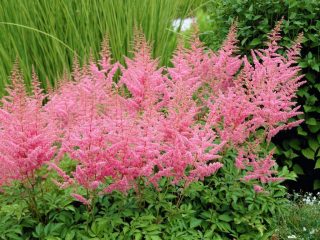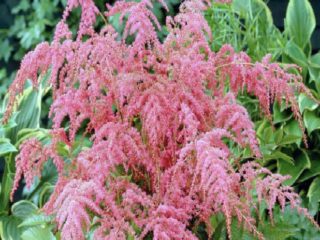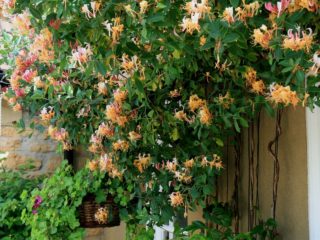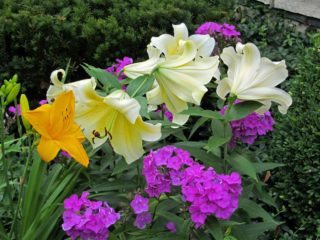Content
Japanese Astilba is an unpretentious frost-resistant ornamental culture that is very popular among gardeners and summer residents. The plant easily tolerates high humidity, therefore it prefers areas with thin shade, located near lakes, rivers and artificial reservoirs. The culture is used to decorate flower beds, personal plots, to create hedges and divide the territory.
General description of Japanese astilba
More than three hundred varieties of astilba are known, divided into 12 groups (undersized, fringed, Lemoine hybrids, prostate, pink and others). Astilba japonica is a perennial herbaceous crop belonging to the Kamnelomkovy family. Differs in compact size, bright dense inflorescences and shiny glossy leaves, which increase the decorative qualities of the plant. Japanese astilba hybrids have predominantly dense inflorescences of various colors. There are nondescript pastel, carmine red, lilac, cream and pink panicles.
The best varieties of Japanese astilba
Botanists have more than 300 varieties of astilba, and this number is increasing. There are Chinese, Korean, Japanese, whole leaf, naked and curly astilbe. There are 4 groups depending on the height (from dwarf to large) and 4 varieties, differing in the shape of the inflorescences (from pyramidal to paniculate and rhombic). Belonging to the variety affects the decorative qualities, stress resistance indicators and other factors.
Vesuvius
Astilba Japanese Vesuvius grows up to 60 cm in height and up to 40 cm in width. Differs in strong, thin and branched stems with dark green leaves and rich carmine-red flowers with a memorable pleasant aroma. Flowering begins in June and lasts almost until the end of summer. For this variety, nutritious, slightly acidic soils, moist and loosened, are best suited.

The Vesuvius variety is resistant to diseases and pests, therefore does not require special care
Washington
The main bush reaches 45 cm in height, peduncles up to 65 cm and above. Leaves are light green in color with openwork outlines. It is a culture in demand among designers due to its unpretentiousness and snow-white loose inflorescences of stunning beauty.

The intense, pronounced aroma of the Washington cultivar resembles the scent of a bird cherry
Montgomery
Astilba Japanese Montgomery is distinguished by lush blood-red inflorescences. Leaves on brown stems change color depending on the season: from brownish-burgundy in spring to dark green in summer. The height of erect peduncles reaches 68 cm.
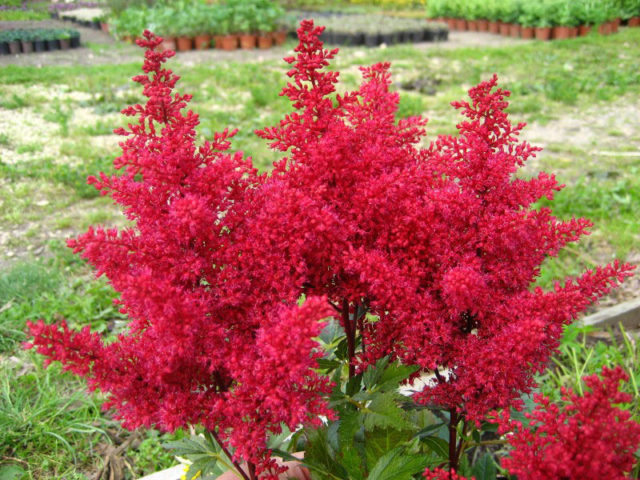
The flowering of the Montgomery variety begins in the second half of July and lasts about two weeks.
Red Sentinel
Astilba Japanese Red Sentinel was bred by Dutch breeders. Chunky bushes reach 0.5 meters in height.Leaves are reddish brown. With the onset of summer, the color changes to a matte green.
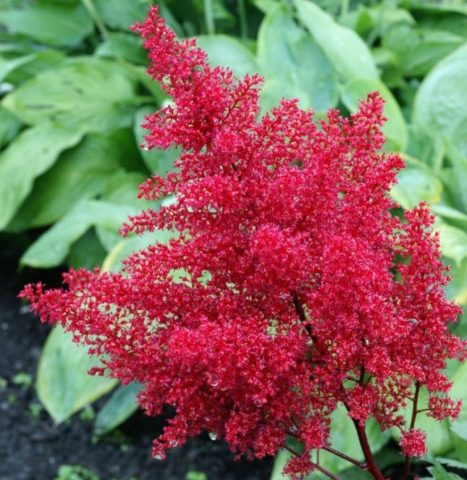
Peduncles of the Red Sentinel variety are large, dark red
They are characterized by pink-white sepals and bluish anthers.
Ellie
Astilba Japanese Ellie has the most snow-white inflorescences in comparison with all other varieties. An adult bush reaches 60 cm in height. Flowering begins in mid-summer. After wilting, the panicles do not change their color to brown, remaining green.
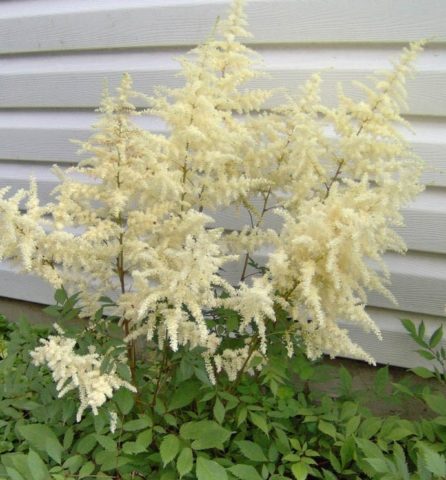
The Ellie variety blooms from mid-July to the second half of August.
Elizabeth Van Veen
Astilba Japanese Elizabeth Van Veen prefers shaded areas where she can grow up to 60 cm in height.
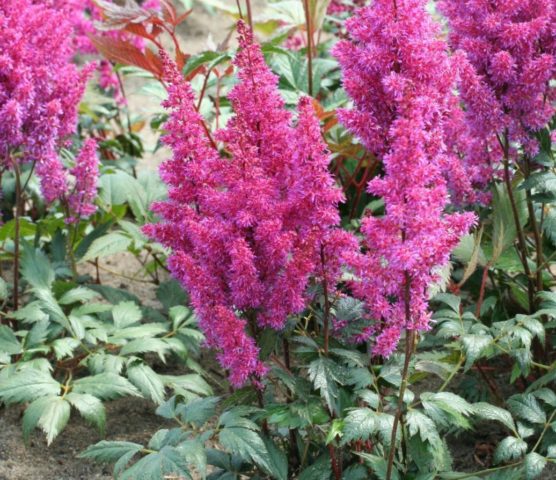
In case of excess sunlight, the height of the Elizabeth Van Win shrub will not exceed 40 cm
In spring, the fringed leaves take on a rich brown-red hue. In the summer they turn green. Peduncles are brown, violet-lilac or violet-crimson.
Deutschland
Astilba Japanese Deutschland reaches 60 cm in height. The bushes are spreading, but at the same time they remain compact.
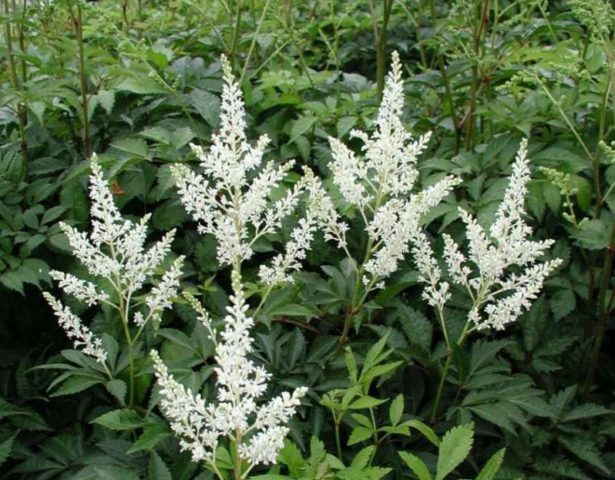
Deutschland is distinguished by medium-dense white inflorescences up to 20 cm long
The buds open in the first days of June and wither after 19-20 days. Before flowering, their color takes on a rich creamy shade.
Dusseldorf
Astilba Japanese Dusseldorf rarely reaches more than 45-50 cm in height.
Differs in large inflorescences with a rich dark pink tint and light green leaves. Flowering usually begins in July and lasts until the end of summer.

The Dusseldorf variety tolerates the abundance of sunlight well only with frequent watering.
Rheinland
The medium-sized Japanese astilbe reaches a height of 70 cm. It is distinguished by large inflorescences with pyramidal carmine-pink panicles, shiny green-bronze foliage with an openwork edging.
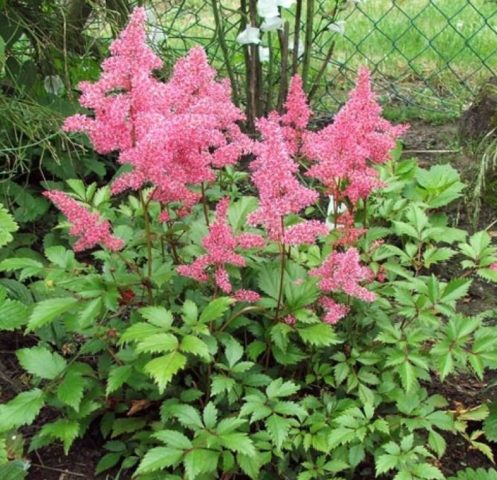
The Rhineland variety develops best when planted near water bodies
The plant begins to bloom in mid-July. Flowering lasts approximately three weeks.
Bonn
Astilba Japanese Bonn is a perennial herbaceous rhizome ornamental culture, which is distinguished by a straight crown, compact size and dense inflorescences of a dark carmine shade.
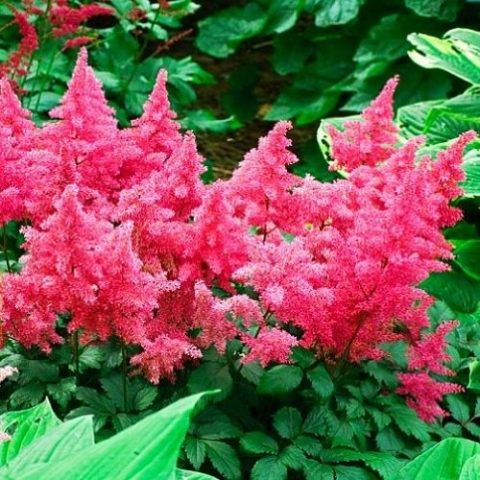
An adult plant reaches 60 cm in height
Differs in high stress resistance and good survival rate. It feels best in the shade of trees next to hosta, aquilegia and ferns.
Europe (Europa)
The maximum height of the peduncles of this spreading variety is 0.5 meters. The tripartite leaves are dark green, the inflorescences have a light pink tint. Thick, lush, odorless. The buds begin to set in late spring, the main flowering period is July. If you cut the bush at the end of August, it will retain its shape until the onset of frost.
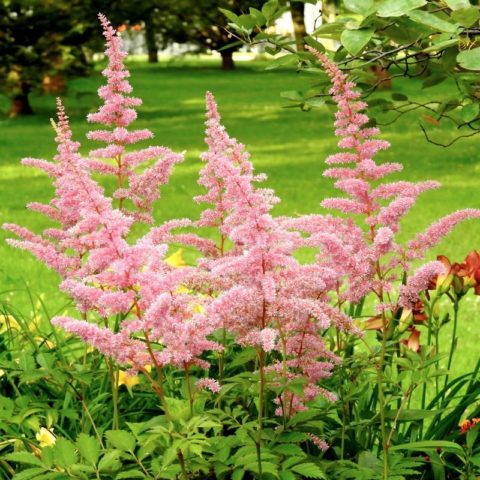
The Europa variety easily tolerates stagnant moisture and excess sunlight.
The Astilba variety of Japanese Europe bears a strong resemblance to Peach Blossom. In order to distinguish one from the other, you need to look at the inflorescences - in Europe they are rhombic, and in Peach Blossom they are paniculate.
Rock and Roll
Astilba Japanese Rock and Roll stands out with reddish straight stems and inflorescences, collected in snow-white panicles. The flower color ranges from pinkish-white to red-lilac. The leaves are deep green with bluish tints. An adult plant reaches a height of 62 cm. It prefers fertilized clay-manure soil.

Rock & Roll is suitable for container growing
It blooms from mid-summer for 30-40 days.
Bronzelaub
The variety was bred by Dutch breeders. The adult plant reaches 62 cm in height.Leaves are purple, bronze-green, diamond-shaped inflorescences are pinkish-red.
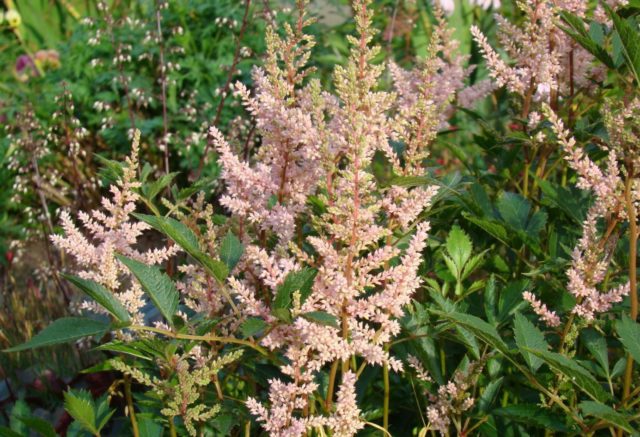
Bronzlaub blooms from mid-July for 2-3 weeks
The optimal conditions for growing this variety are a shaded area with fertile moist soil and high groundwater levels. In case of too hot weather conditions and an abundance of sunlight, the flowering time can be greatly reduced.
Country and Western
Country and Western is distinguished by large, fluffy and very dense diamond-shaped inflorescences with a rich bright pink, red-purple and lilac color.
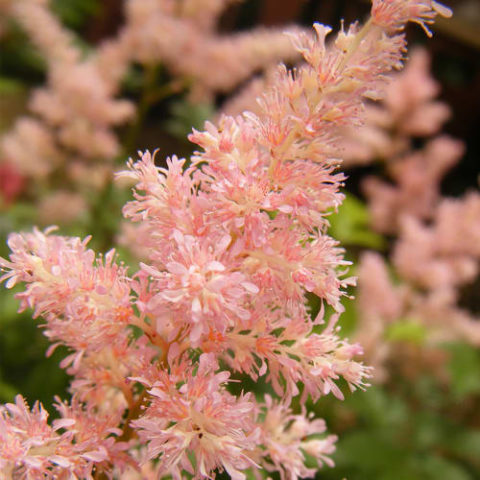
Country and Western belongs to the number of compact varieties, the growth of an adult crop usually does not exceed 50-60 cm
Thanks to its glossy, dark green, double-pinnate leaves, the bush has a spectacular and presentable appearance both during and after flowering.
Chocolate Shogun
Astilba Japanese Chocolate Shogun is very popular.
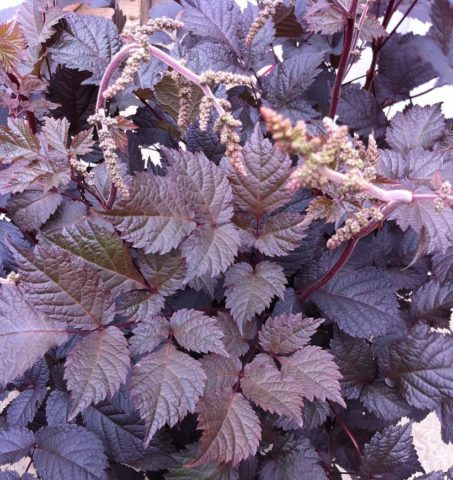
The decorativeness of the culture lies in the dark glossy leaves that retain a rich burgundy-brown hue throughout the year
Inflorescences are creamy pink. Flowering begins in July and lasts until mid-August.
Cologne (Koln)
Herbaceous perennial reaches a height of 55-62 cm. Rhombic paniculate inflorescences are compact, lush, with a pink-crimson tint. The petals are purple-violet, the leaves are greenish-brownish. The Cologne variety is usually planted on the north side of buildings in places with partial shade, protected from the scorching sunlight.
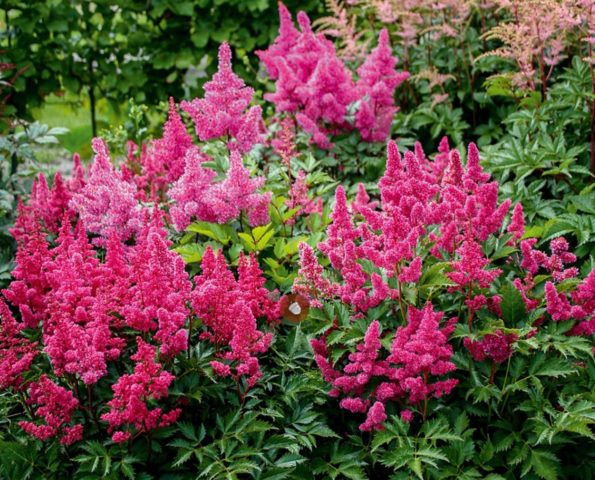
Astilba Japanese Cologne is considered a frost-resistant and moisture-loving culture
Koblenz
Medium-sized perennial herb, reaching a height of 55-60 cm. Leaves are dark green, with small teeth. Small carmine-red flowers are collected in medium-dense fluffy paniculate inflorescences. Used to create group and single landings.
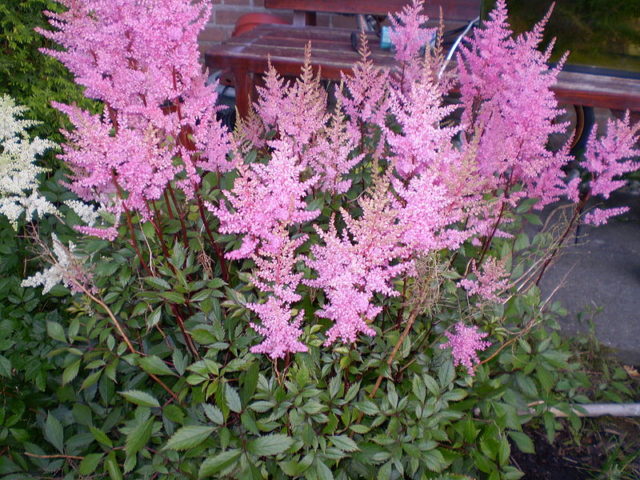
Koblenz saplings are best suited for areas with partial shade, but they can grow in sunny places.
Avalanche
Medium-sized perennial ornamental crop with dark green leaves and white inflorescences. Flowers do not have a pronounced aroma. The height of an adult plant is 55 cm.
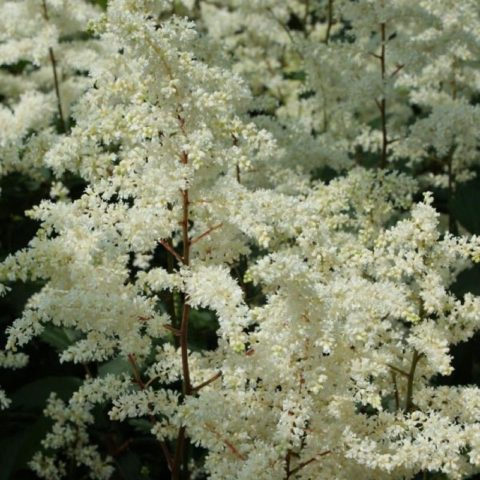
The Avalanche variety takes root well in areas with sparse shade and high humidity.
Too dry air is detrimental to the culture and adversely affects the development and duration of flowering. Used for decorative landscaping, curbs, mixborders and lawns.
Bremen
Widely spreading bushes with small pink-crimson or purple flowers reach 45-55 cm in height. Inflorescences are lush, paniculate, 12 to 17 cm long. Leaves are of a complex shape, with jagged edges.

Prefers places with high humidity: areas near fountains, artificial reservoirs, lakes and rivers
Astilba Japanese Bremen is considered frost-resistant and resistant to diseases and pests.
The use of Japanese astilba in design
Japanese Astilba perfectly coexists with many decorative cultures: Siberian irises, peonies, tulips, lilies of the valley, mountain goat, badan and many others.
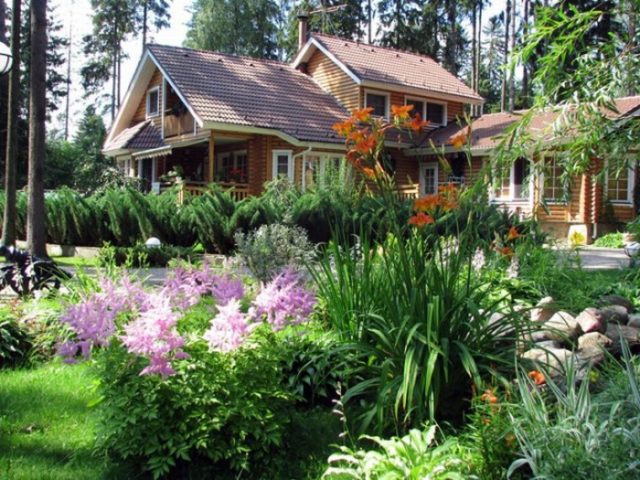
Japanese Astilba fits perfectly into any flower garden and is combined with various plants in mixborders and lawns
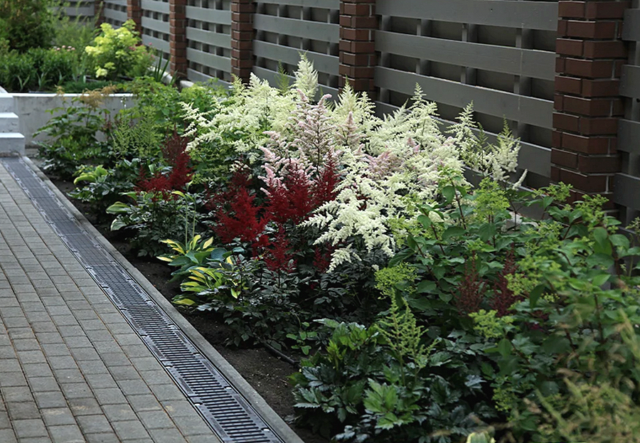
Can be used to create rockeries and landscape compositions
To determine on which plan (front or far) to plant a variety, you must first familiarize yourself with the indicators of its bushiness and tallness.
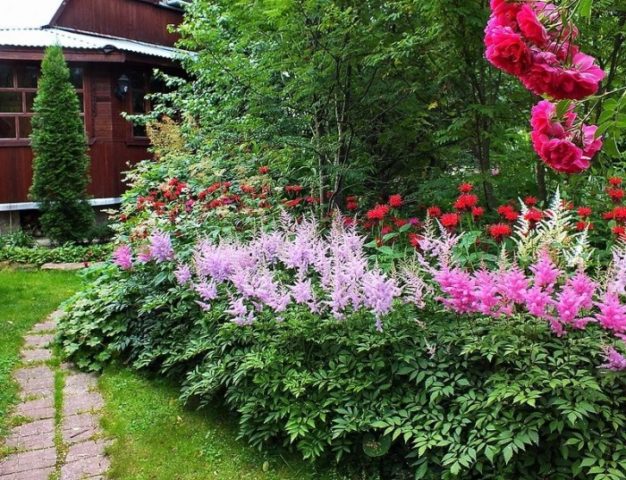
Astilba, planted along the garden path, will play the role of a hedge
With the help of Japanese astilba, you can transform decorative conifers and mixed plantings.
Planting and caring for Japanese astilba
For open ground, Japanese Astilba is better than many other herbaceous plants. The culture prefers places with partial shade, since the abundance of direct sunlight negatively affects growth and flowering rates.The plant is very unpretentious to the soil, however, an area with a high level of groundwater will be optimal. Prolonged drought is detrimental to the culture. The optimal time for the landing of Japanese Astilba is considered the beginning of May. With an autumn transplant, you need to be in time before the onset of frost. The landing of Japanese astilba is carried out according to the following algorithm:
- Depressions are prepared (up to 26 cm). Fertilizers, complex additives and bone meal are poured into the holes.
- The seedling rhizome is cleaned of the earth. Dry roots are removed with a pruner or a knife with a sharp blade.
- It is recommended to place the seedling for several hours in a container filled with water with the addition of a growth stimulator.
Japanese astilba needs periodic feeding, compost, peat, as well as potash and phosphorus fertilizers. Before planting, humus is added to the hole, then it is poured with water. After planting rhizomes with buds, mulching must be performed. Japanese Astilba does not require special care. She only needs regular watering. If the soil dries up, the inflorescences become small, the foliage withers, the plant acquires a sloppy appearance, which negatively affects its decorative properties.
Japanese Astilba has adapted well to the winter cold, however, temperature fluctuations in early spring pose a serious danger to it. Therefore, perennial crops need to provide shelter from spruce branches or other natural materials. The soil between the individual plants is mulched and some pine needles are added. Japanese Astilba bushes are transplanted every few years. It is not necessary to dig up the entire shrub; it is enough to renew the soil around it by sprinkling the cuts with ash.
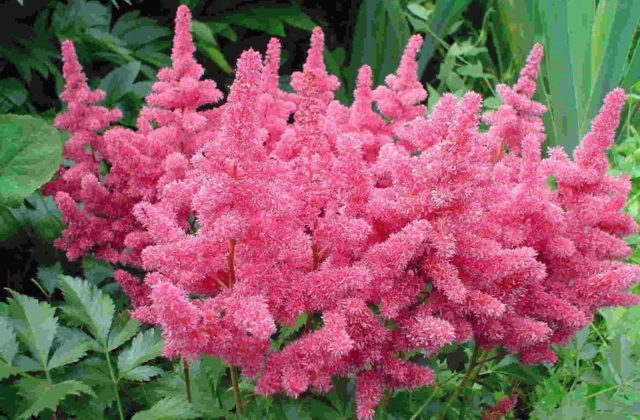
After transplanting, the plant needs abundant watering for two weeks.
Japanese Astilba is a perennial crop that is highly resistant to frost, as well as various diseases and pests. Gall and strawberry nematodes are dangerous to the plant. Signs of damage are reddish and yellowish-brown spots bounded by veins. The leaves become wrinkled and tough. Due to damage by nematodes, the growth rate of astilba is significantly slowed down and decorative qualities deteriorate. You can fight nematodes both mechanically (by dividing into several parts with further quarantine for each), and with the help of special drugs (Bassamil, Nematorin or Nematofagin BT).
Heat treatment is a proven popular method of dealing with parasites. Affected plants are removed from the soil and immersed for several minutes in a container with water preheated to 50 degrees. After the roots have cooled, they are transplanted into a new substrate.
Conclusion
Japanese Astilba is one of the most popular decorative crops. It is unpretentious, resistant to stress and pests, undemanding to care. A perennial plant can decorate any garden area, lawn, curb or mixborder.

